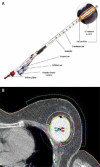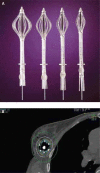Brachytherapy in breast cancer: an effective alternative
- PMID: 26327829
- PMCID: PMC4520341
- DOI: 10.5114/pm.2014.41090
Brachytherapy in breast cancer: an effective alternative
Abstract
Breast conserving surgery (BCS) with following external beam radiation therapy (EBRT) of the conserved breast has become widely accepted in the last decades for the treatment of early invasive breast cancer. The standard technique of EBRT after BCS is to treat the whole breast up to a total dose of 42.5 to 50 Gy. An additional dose is given to treated volume as a boost to a portion of the breast. In the early stage of breast cancer, research has shown that the area requiring radiation treatment to prevent the cancer from local recurrence is the breast tissue that surrounds the area where the initial cancer was removed. Accelerated partial breast irradiation (APBI) is an approach that treats only the lumpectomy bed plus a 1-2 cm margin rather than the whole breast and as a result allows accelerated delivery of the radiation dose in four to five days. There has been a growing interest for APBI and various approaches have been developed under phase I-III clinical studies; these include multicatheter interstitial brachytherapy, balloon catheter brachytherapy, conformal external beam radiation therapy (3D-EBRT) and intra-operative radiation therapy (IORT). Balloon-based brachytherapy approaches include MammoSite, Axxent electronic brachytherapy, Contura, hybrid brachytherapy devices. Another indication for breast brachytherapy is reirradiation of local recurrence after mastectomy. Published results of brachytherapy are very promising. We discuss the current status, indications, and technical aspects of breast cancer brachytherapy.
Keywords: APBI; boost; brachytherapy; breast cancer; recurrence.
Figures





Similar articles
-
Brachytherapy in accelerated partial breast irradiation (APBI) - review of treatment methods.J Contemp Brachytherapy. 2012 Sep;4(3):152-64. doi: 10.5114/jcb.2012.30682. Epub 2012 Sep 29. J Contemp Brachytherapy. 2012. PMID: 23346145 Free PMC article.
-
Accelerated Partial Breast Irradiation (APBI): A review of available techniques.Radiat Oncol. 2010 Oct 4;5:90. doi: 10.1186/1748-717X-5-90. Radiat Oncol. 2010. PMID: 20920346 Free PMC article. Review.
-
Five-year results: the initial clinical trial of MammoSite balloon brachytherapy for partial breast irradiation in early-stage breast cancer.Am J Surg. 2007 Oct;194(4):456-62. doi: 10.1016/j.amjsurg.2007.06.010. Am J Surg. 2007. PMID: 17826055 Clinical Trial.
-
Late side-effects and cosmetic results of accelerated partial breast irradiation with interstitial brachytherapy versus whole-breast irradiation after breast-conserving surgery for low-risk invasive and in-situ carcinoma of the female breast: 5-year results of a randomised, controlled, phase 3 trial.Lancet Oncol. 2017 Feb;18(2):259-268. doi: 10.1016/S1470-2045(17)30011-6. Epub 2017 Jan 14. Lancet Oncol. 2017. PMID: 28094198 Clinical Trial.
-
Accelerated partial breast irradiation.J Surg Oncol. 2011 Mar 15;103(4):362-8. doi: 10.1002/jso.21785. J Surg Oncol. 2011. PMID: 21337572 Review.
Cited by
-
Attitude and practice of brachytherapy in India: a study based on the survey amongst attendees of Annual Meeting of Indian Brachytherapy Society.J Contemp Brachytherapy. 2015 Dec;7(6):462-8. doi: 10.5114/jcb.2015.55666. Epub 2015 Nov 17. J Contemp Brachytherapy. 2015. PMID: 26816503 Free PMC article.
-
Thermally boosted interstitial high-dose-rate brachytherapy in high-risk early-stage breast cancer conserving therapy - large cohort long-term results.Rep Pract Oncol Radiother. 2023 Nov 16;28(5):661-670. doi: 10.5603/rpor.97510. eCollection 2023. Rep Pract Oncol Radiother. 2023. PMID: 38179295 Free PMC article.
-
A systematic review on the techniques, long-term outcomes, and complications of partial breast irradiation after breast-conserving surgery for early-stage breast cancer.Sci Rep. 2024 Sep 27;14(1):22283. doi: 10.1038/s41598-024-73627-x. Sci Rep. 2024. PMID: 39333210 Free PMC article.
-
The Role of Brachytherapy in the Treatment of Breast Cancer.Breast Care (Basel). 2018 Jul;13(3):157-161. doi: 10.1159/000489638. Epub 2018 May 29. Breast Care (Basel). 2018. PMID: 30069174 Free PMC article. Review.
-
Ultrasound-guided Serratus Anterior Plane Block for Accelerated Partial Breast Irradiation using Multi-catheter Interstitial Brachytherapy Technique under Anesthesia in Breast Cancer Patients: A Case Series.Anesth Essays Res. 2022 Jan-Mar;16(1):172-176. doi: 10.4103/aer.aer_18_22. Epub 2022 Jul 18. Anesth Essays Res. 2022. PMID: 36249148 Free PMC article.
References
-
- Clarke DH, Vicini F, Jacobs H, et al. High dose rate brachytherapy for breast cancer. In: Nag S, editor. High dose rate brachytherapy: A textbook. New York: Armonk Futura Publishing Company Inc.; 1994. pp. 321–329.
-
- Gerbaulet A, Potter R, Mazeron J-J, et al., editors. The GEC ESTRO Handbook of Brachytherapy. Bruksela: ESTRO; 2002.
-
- Sauer G, Strnad V, Kurzeder C, et al. Partial breast irradiation after breast-conserving surgery. Strahlenther Onkol. 2005;181:1–8. - PubMed
-
- Polgar C, Major T, Somogyi A, et al. Sole brachytherapy after breast conserving surgery: 4-years results of a pilot study and initial findings of a randomised Phase III trial (abstract) Radiother Oncol. 2000;55(suppl. 1):31. - PubMed
Publication types
LinkOut - more resources
Full Text Sources
Other Literature Sources
